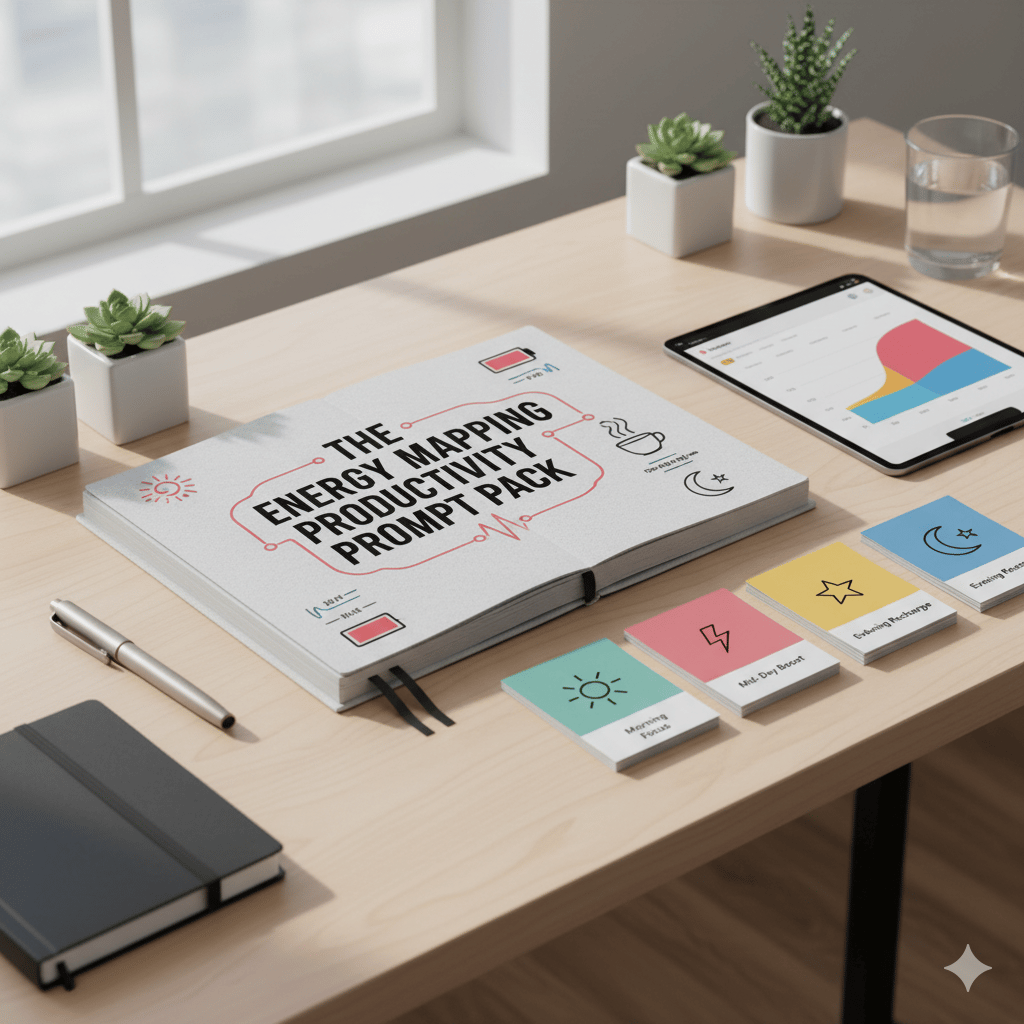- Ark's Newsletter
- Posts
- Beyond the Clock: Why Managing Your Energy is the Real Key to Productivity
Beyond the Clock: Why Managing Your Energy is the Real Key to Productivity
Introduction: The All-Too-Familiar Feeling of Burnout
Consider Steve Wanner, a highly respected partner at Ernst & Young. Before participating in an energy management program, he was working 12- to 14-hour days, feeling perpetually exhausted, and finding it difficult to engage with his family in the evenings. This left him feeling guilty and dissatisfied.
This scenario is an all-too-common response to the rising demands of the modern workplace. The default strategy for many of us is simply to put in longer hours. But this strategy is a recipe for burnout. The solution isn’t about managing time, which is a finite resource we can never get more of. The real breakthrough comes from managing your energy—a resource that is, and always can be, renewable.
This article will provide a practical framework for doing just that. We’ll explore the four interconnected dimensions of your energy and then introduce powerful diagnostic tools, like energy mapping and time blocking, to help you reclaim your focus, engagement, and well-being.

1. The Flaw in Our Thinking: Why “More Time” Isn’t the Answer
The core problem with the “longer hours” approach is that time is a finite resource. No matter how well you organize your calendar, you only have 24 hours in a day. Trying to squeeze more productivity out of a limited resource inevitably leads to negative consequences like exhaustion, disengagement, declining performance, high turnover rates, and even getting sick.
As productivity experts Jim Loehr & Tony Schwartz have said, “Energy is the currency of performance. To perform at your best, you must manage your energy, not just your time.”
This shift in thinking requires us to understand where our energy comes from and how to renew it. The foundation of this approach rests on four core wellsprings of energy.
2. The Four Wellsprings of Your Energy
Energy in human beings comes from four main sources: the body, emotions, mind, and spirit. Energy in each of these dimensions can be systematically expanded and regularly renewed. The key is to establish simple, specific rituals—intentionally practiced and precisely scheduled behaviors—that become automatic over time.
By investing in these four interconnected areas, you can build your capacity, improve your performance, and sustain it for the long term.

3. Mastering Your Energy: A Practical Guide
Here is a practical guide to renewing and managing your energy across each of the four key dimensions.
3.1. Physical Energy: Your Foundation for Performance
Physical energy is the foundation of all other energy dimensions. Inadequate nutrition, exercise, sleep, and rest diminish our basic energy levels, which in turn affects our ability to manage our emotions and focus our attention.
Actionable Rituals:
Honor Your Body’s Rhythms: Our bodies operate on 90- to 120-minute cycles called “ultradian rhythms,” moving from a high-energy state into a physiological trough. Taking brief but regular breaks away from your desk allows you to disengage, change channels, and recover.
Fuel Your Body Strategically: Eating small meals and light snacks every three hours helps stabilize your glucose levels throughout the day. This prevents the energy peaks and valleys that come from eating large, infrequent meals.
Prioritize Sleep and Rest: Getting seven to eight hours of sleep and setting a consistent, earlier bedtime is crucial. When you feel more rested upon waking, you are more motivated for the day ahead.
Without adequate sleep and nutrition, the rituals for managing emotions and attention described next become nearly impossible to sustain.
3.2. Emotional Energy: The Quality of Your Fuel
Controlling your emotions improves the quality of your energy, regardless of the external pressures you face. We perform best when we feel positive energy. Slipping into negative, “fight-or-flight” emotions—like irritability, impatience, or anxiety—drains our energy. This emotional volatility acts as a primary internal distraction, making it impossible to think clearly, logically, and reflectively.
Actionable Rituals:
Defuse Negative Emotions: When you feel a negative emotion rising, “buy time” with a simple ritual of deep abdominal breathing. Exhaling slowly for five or six seconds induces a state of relaxation and effectively turns off the fight-or-flight response.
Reframe Your Story: You can cultivate positive emotions by changing the stories you tell yourself about difficult situations. Instead of viewing yourself as a victim, try looking at the event through three new lenses:
The Reverse Lens:What would the other person in this conflict say, and how might they be right?
The Long Lens:How will I likely view this situation in six months?
The Wide Lens:How can I grow and learn from this situation?
3.3. Mental Energy: Where You Focus, You Succeed
Our capacity for high-quality work is directly tied to our ability to focus. As author Cal Newport defines it, the most valuable work is Deep Work: “cognitively demanding tasks that leverage one’s expertise.” The opposite is Shallow Work: tasks that “consume time without significant value creation,” like responding to routine emails or administrative duties.
Multitasking is one of the biggest myths of productivity because it keeps us in a state of shallowness. Every temporary shift in attention from one task to another incurs what researchers call “switching time.” Think of it as a mental tax you pay every time you switch contexts—a tax that can consume up to a quarter of your workday. It is far more efficient to focus fully in “ultradian sprints” of 90 to 120 minutes.
Actionable Rituals:
Adopt a Deep Work Style: Find a philosophy that fits your life to make deep work a regular practice. You might try the Monastic style (eliminating shallow obligations), the Bimodal style (dedicating clear blocks of days for deep work), the Rhythmic style (scheduling deep work into a daily routine), or the Journalistic style (capitalizing on spontaneous opportunities for focus).
Create a Distraction-Free Zone: When you have a high-concentration task, perform it away from your phone and e-mail. Moving to a separate conference room or quiet space can help you finish complex projects in a fraction of the time.
Batch Your Communications: Instead of reacting to every notification, check and respond to emails and voice mails at designated times. This protects your deep work blocks and prevents your day from becoming a reactive mess.
Define Your Top Priority: Each night before you finish work, identify the single most important challenge for the next day. Make it your very first priority when you arrive at work, before distractions can pull you in other directions.
3.4. Spiritual Energy: Your Sense of Purpose
Spiritual energy is tapped when our work and daily activities are consistent with our core values and provide us with a sense of meaning and purpose. This alignment is a powerful source of motivation, generating more positive energy, improving focus, and increasing perseverance.
Actionable Rituals:
Find Your “Sweet Spot”: Think about the last time you felt completely absorbed and fulfilled in a task at work. What were you doing? That feeling is your clue to finding your “sweet spot” activities—those that give you feelings of effectiveness, effortless absorption, and fulfillment. Identify the work you do best and enjoy most, and find creative ways to dedicate more time to it.
Live Your Core Values: A powerful way to boost spiritual energy is to close the gap between what you say is most important to you and how you actually behave. For example, if consideration is a high value for you but you are perpetually late for meetings, you can create a ritual of intentionally showing up five minutes early.
Understanding these four energy dimensions is the first step. The next is to apply this knowledge to your actual work. A simple but powerful diagnostic tool called “Energy Mapping” will give you the precise data you need to start redesigning your workday around your natural strengths.
4. Your First Step: Create Your Personal Energy Map
To effectively manage your energy, you first need to understand how different types of work impact you. This step-by-step guide uses Patrick Lencioni’s “Six Types of Working Genius” model to help you create a personal energy map and redesign your week for sustainable performance.
Step 1: Identify Your Working Geniuses
The model identifies six distinct phases of work. We all have two that are our “Geniuses” (energizing), two that are “Competencies” (neutral), and two that are “Frustrations” (draining).
Wonder: Gaining energy from questioning the status quo and spotting new possibilities.
Invention: Energized by creating original solutions and brainstorming ideas.
Discernment: Excelling at evaluating ideas with intuition and good judgment.
Galvanizing: Finding energy in rallying and inspiring people to take action.
Enablement: Gaining fulfillment from supporting others and helping initiatives succeed.
Tenacity: Feeling most engaged when driving projects to completion and achieving results.
Take a few moments to identify which two of these feel most like you. These are your Geniuses.
Step 2: List Your Regular Tasks
Make a list of your 10-15 most common work activities. Include everything from leading team meetings and writing reports to answering emails and long-term strategic planning.
Step 3: Categorize Your Tasks by Energy
Now, map your tasks to your energy levels by classifying them into one of three categories, using your Working Geniuses as a guide:
Energizing (Genius): Tasks that align with your natural strengths, making work feel engaging and fulfilling. These activities often create a sense of “flow” and tap into your Working Geniuses.
Neutral (Competency): Necessary tasks you can do well but that don’t strongly impact your energy levels. They may feel routine but contribute to overall success.
Draining (Frustration): Tasks that feel misaligned with your strengths, requiring extra effort and often leading to fatigue. These activities often fall into your areas of Working Frustration.
Step 4: Redesign Your Week with Time Blocking
With your new energy map, you can now redesign your week using time blocking—a strategy where you schedule every part of your day.
Align tasks with your natural energy rhythms. If you’re a “morning person,” schedule your most demanding, Energizing (Genius) tasks for the morning. Save Draining or Neutral tasks for the afternoon when you naturally have less focus.
Batch your draining tasks. Group your Draining tasks together into a single time block. This contains the energy drain and prevents it from poisoning your entire day.
Schedule breaks and be realistic. Just as you schedule meetings, schedule your renewal breaks. Leave some empty blocks for flexibility, as unexpected tasks will inevitably arise.
5. Conclusion: Sustainable Success Isn’t a Sprint—It’s a Series of Smart Recoveries
The core message is simple: sustainable productivity comes not from working longer, but from investing in yourself and systematically renewing your energy. Pushing yourself harder and harder without recovery is a losing strategy.
The results of this approach speak for themselves. In a study at Wachovia Bank, participants in an energy renewal program produced 13 percentage points greater year-over-year revenue from loans and 20 percentage points greater revenue from deposits than a control group.
Sustainable success isn’t about finding a magic productivity app; it’s about making a conscious investment in your most valuable asset: your energy. Start with one small ritual today, and you will begin to reclaim not just your productivity, but your well-being.